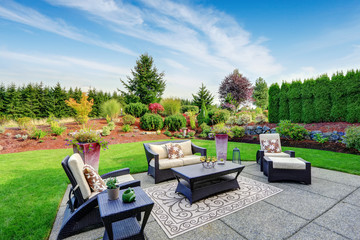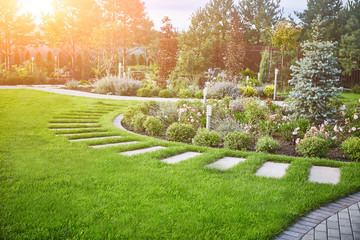Landscaping is the art of changing a small portion of a property to improve its value and aesthetic look. Landscaping Harrisburg PA can include planting, hardscaping, and modifying the ground’s contours. Landscapes can help reduce pollution, protect plants, and increase home value. However, they also require regular maintenance to keep them looking their best.

Landscaping requires extensive research into the natural environment and how it can be manipulated to create a visually pleasing landscape. It also takes extensive maintenance to keep the landscape in good condition.
Creating a focal point for your yard is an important part of aesthetic landscaping. It can be an architectural element, such as a bridge or walkway, or it can be a statue or other decorative object that draws the eye and creates interest in your yard.
In addition to visual appeal, symmetry is an important aspect of aesthetic landscaping. It helps to balance out the overall layout of the yard and makes it easier to maintain over time.
In evolutionary theories, people view landscapes as habitats and aesthetic pleasure is derived from the experience of seeking a suitable habitat. However, people’s aesthetic experience also leads them to change the landscape and affect environmental processes and ecological functions.
Whether you live in a crowded city or an expansive rural home, a healthy landscape can help improve your wellbeing. It offers a sense of escape from the daily stress and demands of modern life, and can even act as a therapeutic experience for those who have suffered from trauma.
Several studies show that looking at nature improves stress levels and decreases blood pressure, as well as improving short-term memory and symptoms of anxiety and depression. Children with ADHD also appear to learn better when they spend time outdoors.
Plants, trees and grasses are also good for the environment, with benefits including reducing cooling costs and water consumption, preventing pesticide run-off, and helping to maintain wildlife habitats. A well-designed landscape can also reduce traffic accidents by creating natural medians, and enhance safety for drivers.
Keeping your commercial landscaping clean is vital to the health and well-being of your staff, customers, and community. Debris and leaves can trap moisture beneath them, making them a prime breeding ground for bacteria that can cause illness.
The health benefits of a clean landscape go beyond aesthetics, as the right cleaning can increase regrowth of grass and other greenery. A clean lawn encourages new growth by allowing sunlight to reach the soil underneath, promoting healthier plant life.
The same holds true for cleaning up your hardscapes, which are often overlooked. Luckily, there are many things you can do to keep them sparkling. One of the best ways to do it is with a power washer. It will remove the dust and grime, leaving behind a shiny new look. The best part is that it also makes your property safer by removing any sharp or jagged surfaces, like branches and tree roots, that could pose a hazard to your employees and patrons.
Landscaping can add tens of thousands of dollars to the value of your property. It’s one of the few home improvements that not only adds value immediately, but increases in value over time as plants grow fuller and more robust with age.
Often the first impression a potential buyer will get is the landscaping in your yard. That can have a big impact on the amount of money you’ll be able to sell your home for.
There are a few things to consider when evaluating your landscaping projects: Curb appeal, maintenance and return on investment.
In addition, it’s important to keep your local climate and region in mind when evaluating your project. Choosing plants and features that are suited to your region will ensure a good return on investment. For instance, drought-tolerant landscaping is a hot trend in western states, where homeowners are looking to save on their water bills. Adding eco-friendly updates, such as low water landscapes, will also increase your property’s value.
overall appearance of a property by creating an attractive and welcoming environment. This can be especially important for businesses, as a well-maintained landscape can help to attract customers and improve their perception of the company. In addition to aesthetics, landscaping can also provide a range of environmental benefits. Trees, plants, and grass absorb carbon dioxide and other pollutants, and release oxygen back into the air. This can help to improve air quality and reduce the impact of climate change. Properly designed landscaping can also help to prevent erosion, reduce water runoff, and create habitats for wildlife.
